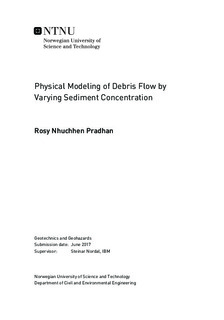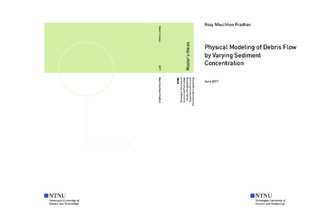| dc.description.abstract | Debris flow is the natural hazard occurring in the mountainous topography. The geography of Norway mostly consists of sloppy terrain with higher steepness. The country receives heavy rainfall every year which is in fact the main triggering factor for the debris flow. Therefore, debris flow has been one of the danger to human life and properties in Norway. To prevent the damage caused by debris flow, proper design of countermeasures is necessary and for this better understanding of debris flow is important. This Master thesis includes the study of debris flow mechanism, basic physics, and its characteristics. Several criteria have been proposed in many literatures for its classification but the most common types are: muddy type which is turbulent and granular or stony type which is less turbulent or laminar. Most of the experimental study existing till now are conducted with muddy flow than with the granular flow. However, the granular flow study is equally important as it can cause severe damage as it carries big bolder with it in suspension. Unlike debris avalanche where only the sliding surface is liquified, debris flow has whole mass liquified in presence of ample water. The rise in pore pressure due to water reduces its effective stress, causes instability of soil mass, and tends it to flow as one phase fluid. The debris flow stops due to either of the two mechanisms: due to reduce in pore pressure and gain in effective stress or due to dissipation of kinetic energy into heat energy. The decrease in sediment concentration of debris flow results in the change in its state to hyper-concentrated flow.
The main objective of this thesis is to study the effect of change in the sediment concentration and change in the volume of debris flow on its parameters: velocity, flow height, deposition height, grain size distribution in deposition area and runout length. A debris flow simulation has been done using physical model of 1:20 scale. To study the change in runout length of the debris slide with varying grain size of material, six tests with debris slide has been conducted using material with two different grain size distribution, one with coarser and other with finer particles. Forty other tests have been conducted for simulating debris flow with varying volume and sediment concentration among which two tests were done with force measurement to evaluate the existing analytical methods for force measurement. The sample for sieve analysis has been taken at the beginning and end of deposition area for each test with debris flow. As some material was left inside the box after every test, the concentration of flow and the mass of solid and water contributing in the flow was not same as the initially intended values. To obtain the actual values of these parameters, the weight of material left inside the box was measured in each test and sample was taken for water content measurement for every test.
The velocity of the debris flow for the test conducted lies within the range of down- scaled velocity of real debris flow event. However, the flow height did not meet the range provided for down- scaled flow height of the real debris flow event. This may be because of the lower volume of mixture used in the test or wider flow channel. Despite of this, the behavior of the debris flow and its character resembled with the actual debris flow event.
The test results revealed that the effect on velocity and runout length due to change in sediment volumetric concentration is more significant for flow with small volume debris flow mixture while the effect due to change in volume of flow mixture, is more for high concentrated flow. The slope of trend line of energy head is steep for debris flow with lower volumes of mixture, thus energy dissipation is rapid for flow with smaller volume. Due to cohesive nature of the fine particles, the material with fine particles have more yield strength than one with less fine particles which is demonstrated by the result of smaller or almost no runout length increment for debris slide with increasing mass of humid material. The surge height in the transport zone increases as the sediment concentration increases which is vice versa for surge height in the deposition area. The effect of concentration change in surge height at upstream (transport zone) and downstream (deposition area) is more for debris flow with high volume and surge height downstream increases as total volume increases. Inverse grading is observed for debris flow, while no distinct grading is observed for hyper-concentrated flow. The degree of coarseness of material increases from the beginning to end of deposition area. The degree of coarseness of the deposits at the beginning increases with decreasing volume and increasing concentration and it is just the opposite at end of deposition area. Force measured in test is close to existing mixed model of hydrostatic and hydrodynamic model.
In conclusion, the test results satisfied the existing concept and character of the debris flow. The trend of change of runout length, flow heights, deposition height, grain size distribution with change in sediment concentration or change in volume of mixture supported the existing theory. The force measurement satisfied the existing analytical methods. Thus, the test results can be used to calibrate the numerical simulating tool for simulation of real debris flow phenomena. | |

